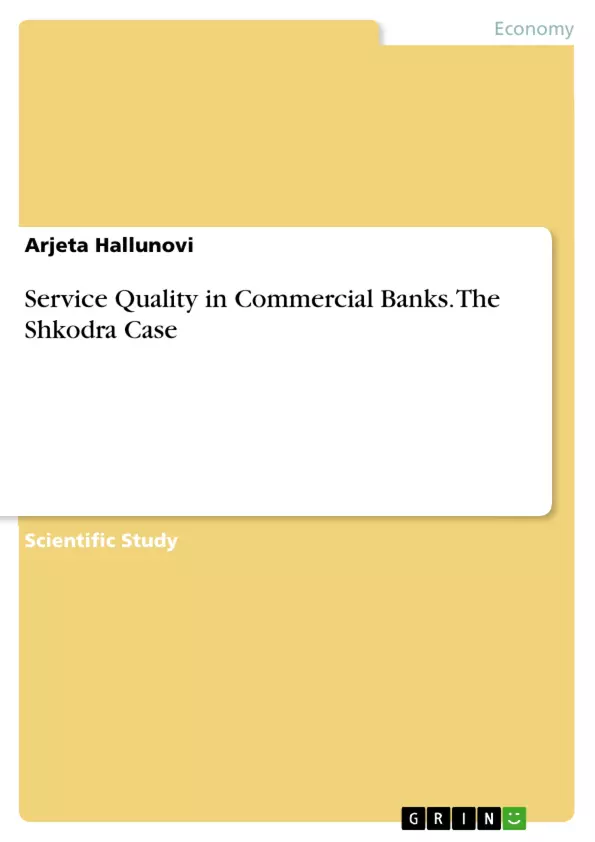The issue of service quality has been at the center of the ongoing academic and business interest since the late 1970s. Of course buyers have always been concerned about quality, but increasing competition in the current markets of many services has made consumers more selective in the service they choose.
The study focuses on banking services, their quality and customer satisfaction in the banking system: as a case study, services provided by banks in Shkodra have been taken. For the realization of the study a complete analysis was used based on the data collected from the questionnaire with the clients of the commercial banks operating in Shkodra. The data provided by the questionnaire analyzed the real level of banking services in Shkodra. These services are seen in terms of their diversity as well as the level of quality of services they offer to attract the customer. The study also highlights the gaps that these banks have in their services under contemporary conditions.
The purpose of this study is to confirm the theory that banks should do more to perceive the customer about the quality of services. Banks try to provide modern services, but the most important is to identify and perceive customer needs about services because what may be good for the bank may not be the good for the customer.
Inhaltsverzeichnis (Table of Contents)
- CHAPTER I
- Introduction
- Literature Review
- Methodology
- CHAPTER II
- Banking System in Albania
- Banking System Developments in Albania
- Banking System in Terms of Definition
- The Role of Banks in the Economy and Their Functions
- General Features of the Banking System in 2016
- Bank Notions and Services
- The Services That Banks Offer to the Customers
- Characteristics of Banking Services
- Tangibles
- Indivisibility
- Variability
- Non-inventory
- Financial responsibility
- Double information
- What Do We Mean by Quality of Service?
- SERVQUAL Model: Service Quality Dimensions
- Information Technology
- Commitment by Management in Implementing Quality Banking Services
- Information Quality Systems Services
- Importance of Quality in Financial Terms
- Benefits from Quality Improvements
- Quality Improvement Model and Profitability
- Quality on Return (ROQ)
- Customer Satisfaction and Quality of Service
- Total Quality Perceived by Gronroos
- Characteristics of the Quality of Banking Services Today
- Changing Customer Needs and Expectations
- Increasing Integration in Quality of Service
- Competition, the Quality of Services and Their Role in Economic Development
- CHAPTER III
- Discussion: Banking Sector, Crediting to economy and Their Impact on Economic Development
- The role of lending to the economy
- Crediting to the economy during 2006 - 2016
- CHAPTER IV
- Research Results
- Empirical Analysis
- General Information for Respondents
- Characteristics of Service Quality Offered by Banks
- What do Customers Expect from the Service Offered?
- Improving the Quality of Services
- What do Banks Expect in the Future from their Customers?
- Conclusions of the Questionnaire
- CHAPTER V
- Conclusions and Recommendations
Zielsetzung und Themenschwerpunkte (Objectives and Key Themes)
This study aims to investigate the relationship between service quality and customer satisfaction within the banking system in Shkodra, Albania. It explores the level of quality of services offered by banks in the region, the diverse services provided, and customer expectations. The study also aims to identify gaps in existing services and highlight the importance of aligning bank services with customer needs for enhanced satisfaction and profitability.
- Service quality and its impact on customer satisfaction
- The role of banking services in economic development
- Customer expectations and their influence on service quality
- The importance of aligning banking services with customer needs
- The significance of technology and information systems in enhancing service quality
Zusammenfassung der Kapitel (Chapter Summaries)
Chapter I provides an introduction to the study, outlining the significance of service quality and its increasing relevance in the modern banking industry. It highlights the evolution of the Albanian banking system, the impact of technology, and the growing demand for quality financial services. Chapter II delves into the specifics of the banking system in Albania, discussing its structure, functions, and key features. It examines the characteristics of banking services, explores the concept of service quality, and introduces the SERVQUAL model for measuring service quality dimensions. This chapter further emphasizes the importance of information technology and customer satisfaction in enhancing the overall quality of banking services. Chapter III explores the role of lending to the economy in Albania, focusing on the impact of crediting on economic development during the period between 2006 and 2016. Chapter IV presents the empirical analysis of the study. It delves into the research methodology, discusses the general information obtained from respondents, and examines customer expectations regarding service quality. It also explores the strategies for improving the quality of services and the future expectations of banks from their customers.
Schlüsselwörter (Keywords)
The core focus of this study lies in examining the crucial relationship between service quality and customer satisfaction within the Albanian banking system. Key terms encompass service quality, customer satisfaction, banking system, banking services, profitability, and economic development. The study investigates the diverse services offered by banks, their perceived quality, and how these elements contribute to overall customer satisfaction and ultimately, the economic growth of the region.
- Quote paper
- Arjeta Hallunovi (Author), 2018, Service Quality in Commercial Banks. The Shkodra Case, Munich, GRIN Verlag, https://www.grin.com/document/444978



